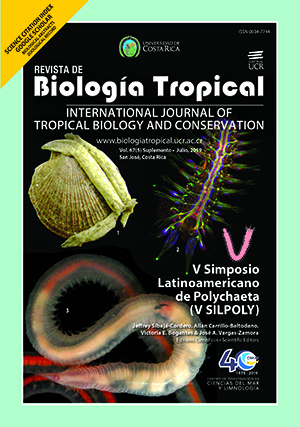Abstract
Introduction: The sipunculans are a group of marine invertebrates that have been little studied in the tropical eastern Pacific (TEP). Antillesoma antillarum is a species belonging to the monospecific family Antillesomatidae, considered widely distributed in tropical and subtropical localities across the globe. Objective: The main objective of this work was to examine the morphological and molecular differences between specimens from both coasts of tropical America to clarify the taxonomy of this species. Methods: We examined the morphology with material from the Mexican Caribbean and southern Mexican Pacific. To perform molecular analyses, two sequences of the COI molecular marker were obtained from specimens collected in Panteón Beach, Oaxaca, southern Mexican Pacific, and compared with four sequences identified as A. antillarum in GenBank, all of them from different localities. A phylogenetic reconstruction was performed with the maximum likelihood method and genetic distances were calculated with the Kimura 2P model and compared to reference values. Results: The phylogenetic analysis revealed three different lineages of Antillesoma that are well supported by bootstrap values: Antillesoma antillarum sensu stricto from the Caribbean Sea and Florida; a sister group to the one represented by our samples from the Mexican Pacific; and a third group from Thailand. Conclusion: Based on morphological traits and molecular data, Antillesoma mexicanum sp. nov. is described from the Mexican Pacific, differing from A. antillarum in the trunk papillae, color patterns and, additionally, the specimens from the Caribbean attain significantly bigger trunk sizes than the ones Pacific.
References
Boyle, M. J., & Rice, M. E. (2018). Comparative development and the evolution of life history diversity in Sipuncula. Smithsonian contributions to the marine sciences, 42, 11-34.
Cutler, E. B. (1994). The Sipuncula. Their systematics, biology, and evolution. Ithaca, Nueva York: Cornell University Press.
Cutler, E. B., & Cutler, N. J. (1983). An examination of the Phascolosoma subgenera Antillesoma, Rupellisoma, and Satonus (Sipuncula). Zoological Journal of the Linnean Society, 77, 175-187.
Cutler, E. B., & Gibbs, P. E. (1985). A phylogenetic analysis of higher taxa in the phylum Sipuncula. Systematic Zoology 34, 162-173.
Dordel, J., Fisse, F. Purschke, G., & Struck, T. H. (2010). Phylogenetic position of Sipuncula derived from multi-gene and phylogenomic data and its implication for the evolution of segmentation. Journal of Zoological Systematics and Evolutionary Research, 48, 197-207.
Folmer, O., Black, M., Hoeh, W., Lutz, R., & Vrijenhoek, R. (1994). DNA primers for amplification of mitochondrial cytochrome coxidase subunit I from diverse metazoan invertebrates. Molecular Marine Biology and Biotechnology, 3, 294-299.
Gibbs, P. E., & Cutler, E. B. (1987). A classification of the phylum Sipuncula. Bulletin of the British Museum (Natural History), 52, 43-58.
Grübe, E. (1858). Enumeratio Annulatorum, quae in itinere per Indiam occidentalem et Americam centralem annis 1845-1848 suscepto legit cl. A. S. Örsted, adjectis speciebus nonnullis a cl. Köyero in itinere ad Americam meriodionalem colectis, Annulata Örstediana, Copenhagen: Videnskabelige Meddelelser fra Dansk naturhistorisk Forening I Kjobenhaven, 105-120.
Guindon, S., Dufayard, J. F., Lefort, V., Anisimova, M., Hordijk, W., & Gascuel, O. (2010). PhyML 3.0: new algorithms, methods and utilities. Systematic Biology, 59(3), 307-321.
Hall, A. (1999). BioEdit: a user-friendly biological sequence alignment editor and analysis program for Windows 95/98/NT. Nucleic acids symposium series, 41, 95-98.
Jaramillo, C. A., Hoorn, K., Perrigo, A., & Antonelli, A. (2018). Evolution of the Isthmus of Panama: biological, paleoceanographic and paleoclimatological implications. In C. Hoorn, A. Perrigo, & A. Antonelli (Eds.). Mountains, climate and biodiversity (pp. 323-338). Oxford, UK: Wiley-Blackwell Ltd.
Johnson, N. D., Sanders, C., Mairova, A., & Schulze, A. (2016). Cryptic species in Pacific sipunculans (Sipuncula: Phascolosomatidae): east west divergence between non-sister taxa. Zoologica Scripta, 45, 455-463.
Kawauchi, G. Y., & Giribet, G. (2010). Are there true cosmopolitan sipunculan worms? A genetic variation study within Phascolosoma perlucens (Sipuncula, Phascolosomatidae). Marine Biology, 157, 1417-1431.
Kawauchi, G. Y., & Giribet, G. (2014). Sipunculus nudus Linnaeus, 1766 (Sipuncula): Cosmopolitan or a group of pseudo-cryptic species? An integrated molecular and morphological approach. Marine Ecology, 35, 478-491.
Kawauchi, G. Y., Sharma, P. P., & Giribet, G. (2012). Sipunculan phylogeny based on six genes, with a new classification and the descriptions of two new families. Zoologica Scripta, 41, 186-210.
Kumar, S., Stecher G., & Tamura, K. (2016). MEGA7: Molecular Evolutionary Genetics Analysis Version 7.0 for Bigger Datasets. Molecular Biology and Evolution, 33, 1870-1874.
Lemer, S., Kawauchi, G. Y., Andrade, S. C. S., González, V. L., Boyle, M. J., & Giribet, G. (2016). Re-evaluating the phylogeny of Sipuncula through transcriptomics. Molecular Phylogenetics and Evolution, 83, 174-183.
Lessios, H. (2008). The great American schism: divergence of marine organisms after the rise of the Central American Isthmus. Annual Review of Ecology, Evolution and Systematics, 39, 63-91.
Murina, V. V. (1984). Ecology of Sipuncula. Marine Ecology Progress Series, 17, 1-7.
Saiz, J. (2018). World Sipuncula database. Sipuncula. In World Register of Marine Species. Retrieved from: http://www.marinespecies.org/aphia.php?p=taxdetails&id=1268.
Schulze, A., Maiorova, A., Timm, L. E., & Rice. M. E. (2012). Sipunculan larvae and “cosmopolitan” species. Integrative and Comparative Biology, 52, 497-510.
Staton, J. L. (2003). Phylogenetic analysis of the mitochondrial cytochrome c oxidase subunit I gene from 13 sipunculan genera: intra-and interphylum relationships. Invertebrate Biology, 122, 252-264.
Staton, J. L., & Rice, M. E. (1999). Genetic differentiation despite teleplanic larval dispersal: allozyme variation in sipunculans of the Apionsoma misakianum species complex. Bulletin of Marine Science, 65, 467-80.
Struck, T. H., Schult, N., Kusen, T., Hickman, E., Bleidorn, C., McHugh, D., & Halanych, K. M. (2007). Annelid phylogeny and the status of Sipuncula and Echiura. BMC Evolutionary Biology, 7, 57.
##plugins.facebook.comentarios##

This work is licensed under a Creative Commons Attribution 4.0 International License.
Copyright (c) 2019 Revista de Biología Tropical


